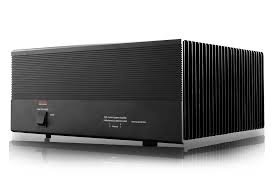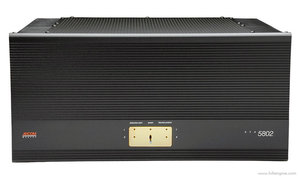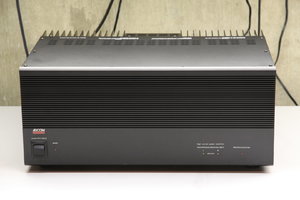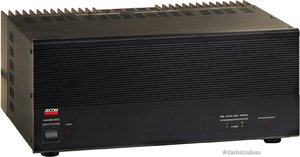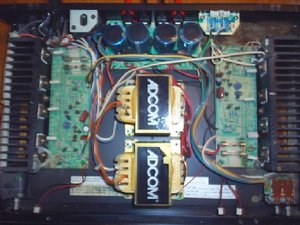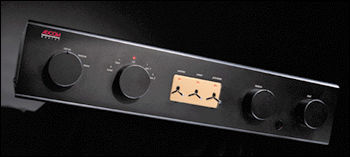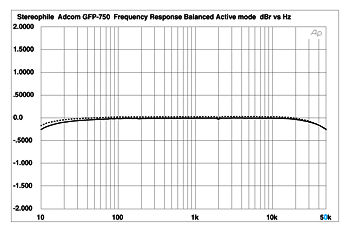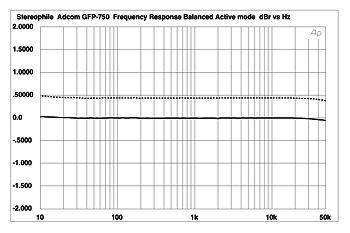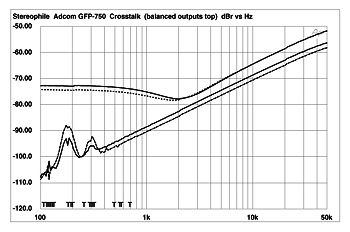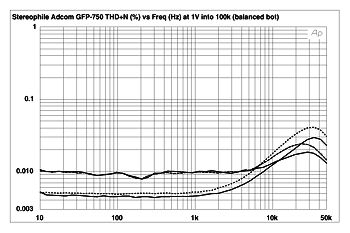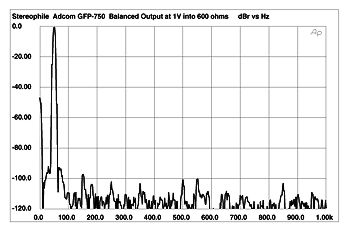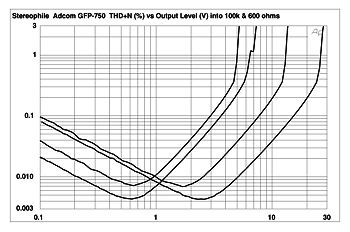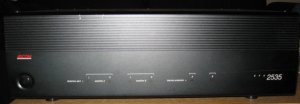Her er omtalen av Adcom GTP - 750 publisert i Sterephile i 1999. Grunnen til at jeg poster den er i hovedsak at flere har nevnt omtalen denne fikk i Fidelity der de nesten latterliggjorde stereophile's skribenter og deres sammenligning av denne pre'en med dyrere produkter. Stereophile har en del målinger å vise til her. Fidelity får bare synset.
Adcom GFP-750 preamplifier
Wes Phillips, March, 1999
Adcom is one of those companies that's just too consistent for its own good. Year after year, they put out well-engineered, fairly priced gear, while we audiophiles become jaded and almost forget they're there... You want a good-sounding CD player that doesn't cost an arm and a leg? [Yawn.] Well, you could try Adcom. Need a power amplifier with some sock that won't make your tweeters crawl down your ear? There's always Adcom.
To break through our complacency, Adcom would have to produce an outright unlistenable turkeyor a product that raised the bar so high that any audio manufacturer would get a hernia just thinking about raising it again.
Well, brace yourself, BridgetAdcom's GFP-750 is a solid-state preamplifier/passive line controller that will demolish your expectations.
At least...do no harm (footnote 1)
The GFP-750 looks like an Adcom component. It ain't fancyjust a solid black box with four rotary knobs and a discreet brass rectangle sporting three levers. I do mean solid: This 15-lb preamp has a rugged, no-nonsense feel. Two of the four sturdy knobs control electronic switches that choose the source, and set the outputs to stereo, reverse, or mono. The other two, motor-driven for remote control, adjust volume and balance. The three switches toggle between passive and active output, power on and off, and engage a processor bypassa handy way to integrate multichannel capabilities.
The rear panel accommodates one pair of balanced XLR outputs and one balanced XLR input pair. It also features four additional RCA inputs, a processor loop on RCAs, two pairs of RCA outputs, and remote sensor and repeater jacks.
The GFP-750 is a Nelson Pass designessentially a variation on the Pass Labs Aleph P and Pass's DIY project, The Son of the Bride of Zen (footnote 2). The circuit couldn't be simpler. Says Pass, "It's a differential pairthe end. A single gain stage, balanced input, balanced output, no feedback....We took a pair of MOSFETs, and the inputs go to the gates of the MOSFETs. The MOSFET sources are tied together and biased with a current source, with the signal taken off the drains. [The circuit] can run unbalanced on either side, although the performance is best when it's run balanced."
Other than glue logic and the transistors used to drive the relays, the 12 active devicesfour gain blocks, each with three devicesare HEXFETs from International Rectifier. The output stage is intended to function as a pure voltage source, making the GFP-750 relatively immune to cable differences or low amplifier impedances. As we've come to expect from Adcom, the preamp sports a honkin' big toroidal transformer, with multiple secondary windings for each channel. A large heatsink on the left-hand side carries the power supply regulator chips.
Both signal and control circuitry is carried on one large double-sided printed circuit board, though these are physically separated. The parts quality is superb throughout, and care has been taken to keep signal paths as short as possible. The input switching relays, for example, are all adjacent to the rear-panel sockets. Did somebody mention the proverbial brick outhouse?
In passive mode, the signal sees only input switching and the attenuator.
Life is short, the art long . . .
You'd think that designing a preamplifier would be simplicity itself, especially in these days of line-level sources. But the truth is, getting rid of a preamp's electronic fingerprint hasn't proven that easydo a bypass test and the difference can be astounding. Preamps, even well-regarded ones, seem to compress dynamic range, muffle low-level details, and generally throw one of those much-talked-about veils over the sound. Some digital sources, like Wadia's processors and players and a handful of others, allow you to jettison your preamp, at least as a volume control, but you're plumb out of luck if you need to switch between multiple analog and digital sources.
The GFP-750 must be a disciple of Hippocrates, because it does about as little to a system's sound as any preamplifier I've heardat any price. There is a slightextremely slightsoftening of details when it's used as an active preamplifier, but many audio cables have more sonic impact than the '750. So do most other preamps, for that matter. If you need to drive a long run of cable, or if you have a difficult amplifier impedance, I wouldn't hesitate to use the GFP-750's active circuitry.
In comparisons with the $1495 Audio Research LS8 (reviewed elsewhere in this issue by Martin Colloms), the active GFP-750 sounded considerably more open and extended. On discs with deep bass, such as Robert Rich's Seven Veils (Hearts of Space 11086-2), the Adcom quite simply captured the power and heft of the synth-produced bottom end in a way that the Audio Research did not. Without the direct comparison, I would probably have been quite happy with the LS8's bass response, but the Adcom had a lot more impact down under.
Nor did the LS8 reproduce the harmonic overtone structure of the recorders on the Flanders Recorder Quartet's Armonia di Flauti (CD, Opus 111 OPS 30-201) with the harsh and extremely extendedextremely aliveeffervescence of the GFP-750. That harshness, which almost clangs, is what gives this fantastic-sounding CD its sparkle, but it was subdued by the LS8.
Againwhile I clearly heard the Adcom as having superior overtone presentation in a direct comparison with the Audio Research, I did not find the ARC particularly closed-down on its own. It is not as transparent as the best preamps I've heardwhich the Adcom isbut it is by no means among the most colored either. It's enjoyable, if not exemplary. The Adcom is both.
Actually, the preamplifier that most reminded me of the GFP-750 was the Mark Levinson No.380S, which costs $6495. The two had similarly open, grainless characters. In direct comparisons I had an extremely difficult time discerning differences between themand that was a sighted comparison!
Blindfold me and ask me to identify which one was playing and I'd probably have to flip a coin.
Unless the Adcom was in passive mode, when it was the sonic equivalent of nothing at all. What's it sound like? After many hours of listening, I'd have to say, "What did what sound like?" The GFP-750 is the preamp for the audiophile who hates preamps.
But if I had to describe the sound of no preamp, I'd say open, open, open. Open as in huge soundstage, uncompressed, nakednary a veil in sight.
Not everybody prefers their sound so unembellished. I'm not sure I always dosometimes a little euphony can be very appealing. That's okay. There's a lot to be said for liking something simply because it's pretty... But if you want to hear what the signal really sounds like, then the Adcom is the preamp for you.
Experiment treacherous, judgment difficult
But sometimes, judgment is simple. Adcom's GFP-750 is a remarkable preamplifier. It's well-built and elegantly designedon the inside, where it counts. I've gone just gaga over it, not simply because it performs well for the money, but because it begs comparison with the best preamplifiers I've ever heard. Period. No matter how much you've budgeted for a stereo preamplifier, listen to the GFP-750 first. If you end up choosing something else, then you'll know that your choice is very good indeed.
Sidebar 1: Specifications
Description: Solid-state, remote-control preamplifier switchable to passive attenuator/switcher. Rated main output level: 1V. Frequency response: 5Hz-85kHz, ±0.5dB. S/N ratio: >102dB, A-weighted. Input sensitivity: 183mV balanced, 365mV unbalanced. Input impedance: 94k ohms balanced, 47k ohms unbalanced. Output impedance: 1200 ohms balanced, 600 ohms unbalanced.
Dimensions: 17" W by 4.25" H by 12" D. Weight: 15 lbs.
Serial number of unit reviewed: P751DB 01896.
Price: $1250. Approximate number of dealers: 400.
Manufacturer: Adcom, 10 Timber Lane, Marlboro, NJ 07746. Tel: (732) 683-2356. Fax: (732) 683-2358. Web:
www.adcom.com .
Sidebar 2: Associated Equipment
LP playback: Linn LP12 Lingo/Cirkus/Ekos/Arkiv.
CD playback: Audio Research CD2/DAC3, Linn CD12 Sondek, Sonic Frontiers Iris 3 transport/DAC 3.
DVD player: Denon DVD-3000.
Preamplification: Linn Linto phono section, Audio Research LS8, Conrad-Johnson ART preamplifier, Mark Levinson No.380S.
Power amplifiers: Accuphase m2000, Audio Research VT200, Cary 805C, Mark Levinson No.332.
Loudspeakers: Alón Circe, B&W Silver Signature.
Cables: AudioQuest Lapis, Madrigal CZ-Gel 1, Siltech SQ-80B G3.
Accessories: API Power Wedge Ultra, Cinemedia PowerPro 20 Professional Series AC Line Balancer, OSAR equipment and amplifier racks.
Room Treatment: ASC Tube Traps, Studio Traps, Bass Traps; RPG Abffusors; eumorphous feline.Wes Phillips
Sidebar 3: Measurements
I agree with Wes Phillips about the sheer quality of the Adcom GFP-750's construction. One thing that had me confused was that the passive option is selected when the red LED above the switch is illuminated. For some reason, I assumed that the light being on meant that the active stage was engaged. Serves me right for not reading the manual!
Once I got that out of the way, I started to measure the GFP-750. The mute control gave a full mute to silence; the unity gain setting of the volume control in active mode was at the 2:00 position; and the preamp was noninverting from the unbalanced outputs and from the balanced XLR jacks (pin 2 is wired as hot). (Throughout this section, "unbalanced" means an unbalanced source into the GFP-750's Aux 1 jacks and an unbalanced output from its RCA jacks; "balanced" means a balanced source into the balanced CD input XLRs and a balanced output from the XLR jacks.)
The maximum gain in active mode was 8.33dB unbalanced and 14.33dB balanced. In passive mode with the volume control set at its maximum, the output dropped from unity gain by a negligible 0.145dB. The input impedance was 21.1k ohms in active unbalanced mode, this dropping to a low 1945 ohms in unbalanced passive mode. Both figures are lower than specified, but this should not be a problem unless the source used has a high source impedance, such as some tube CD players.
The output impedance in active mode was a little higher than specified, at 970 ohms unbalanced, 1920 ohms balanced. This should present no problems. In passive mode, the output impedance will depend on the setting of the volume control. I checked at three positions: with the control wide open, the calculated impedance was 14 ohms, presumably due to the Audio Precision's 25-ohm source impedance being shunted by the potentiometer resistance; with the control at 10:00, the output impedance rose to 168.75 ohms; and at the 2:00 position it was 512 ohms. None of these figures will give rise to problems unless the Adcom is used with very long lengths of highly capacitive cable.
The frequency response in passive mode was, as expected, ruler-flat. In active mode (fig.1), a small but negligible rolloff can be seen above and below the audio band. A note on the excellent channel balance seen in this graph: It appears that any imbalance in the volume-control tracking and the gain of the active stages has been optimized for the balanced CD inputs. Repeating the measurement for the unbalanced Aux 1 input in active mode gave the response shown in fig.2: there is now a 0.4dB channel difference at the 2:00 volume-control setting used for this measurement. This is trivial, and was easily corrected by setting the balance control to 11:45, but it did puzzle me at first.
Fig.1 Adcom GFP-750, frequency response into 100k ohms, balanced active mode, with volume control set to 2:00 (0.5dB/vertical div.).
Fig.2 Adcom GFP-750, frequency response into 100k ohms, unbalanced passive mode, with volume control set to 2:00 (0.5dB/vertical div.).
The channel separation was fine, though the crosstalk in balanced active mode (fig.3, top traces) was a little higher than in unbalanced mode (bottom traces). Above 2kHz, both graphs showed a rise in crosstalk due to capacitive coupling between the channels, but this was still less than -60dB below 16kHz.
Fig.3 Adcom GFP-750, Crosstalk (from top to bottom): L-R, R-L, balanced mode; L-R, R-L, unbalanced mode (10dB/vertical div.).
Distortion (fig.4) was very low in both active modes, if a little higher in unbalanced mode and at high frequencies. Despite (or because of?) its minimal circuitry, the GFP-750 is very linear. Fig.5 shows the spectrum of the balanced output driving 50Hz at 1V into a 600 ohm load. This is a punishingly low load for a preamplifier to drive; even so, the distortion harmonics are negligible in level, other than the third at almost -100dB, which is still extremely low. In unbalanced mode, AC-supply harmonics at 180Hz and 300Hz made their presence known, but were still well down (below -80dB) in absolute level.
Fig.4 Adcom GFP-750, THD+noise vs frequency at 1V into 100k ohms, unbalanced mode (top at 1kHz), balanced mode (bottom).
Fig.5 Adcom GFP-750, spectrum of 50Hz sinewave, DC-1kHz, at 1V into 600 ohms, balanced active mode (linear frequency scale).
Finally, fig.6 shows the GFP-750's percentage of distortion+noise in both balanced and unbalanced modes, plotted against output voltage into loads of 100k ohms and 600 ohms. At a 1% THD+N figure, the maximum output voltage in balanced mode was 26.5V (100k ohms) and 6.5V (600 ohms); in unbalanced mode, it was 13.3V (100k ohms) and 5.0V (600 ohms). All voltages are well above the level required to drive any known power amplifier well into clipping. Note that the shapes of these traces imply that the preamplifier offers its lowest level of distortion and noise at around 2V, the maximum voltage likely with a real-world power amplifier.
Fig.6 Adcom GFP-750, distortion (%) vs output voltage into (from right to left): balanced mode into 100k ohms, unbalanced mode into 100k ohms, balanced mode into 600 ohms, unbalanced mode into 600 ohms.
This fine set of measurements indicates good engineering.John Atkinson
Footnote: 1 All headers by Hippocrates.
Footnote 2: See
www.passlabs.com for more information on these products. While there, you can also access patent 5,376,899, which covers the GFP-750's circuit.


